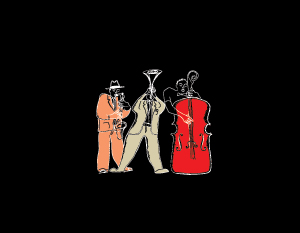Putting Jazz in its Place
by Theodore Buehrer '91, James D. and Cornelia W. Ireland Associate Professor of Music
 It sometimes feels peculiar leading Kenyon's jazz ensemble. I don't mean that the study of jazz shouldn't have a place in academia. On the contrary, the last fifty years have seen an explosion of interest in jazz education, and this is as it should be. Today, jazz is more widely celebrated as an art form than at any time in its history.
It sometimes feels peculiar leading Kenyon's jazz ensemble. I don't mean that the study of jazz shouldn't have a place in academia. On the contrary, the last fifty years have seen an explosion of interest in jazz education, and this is as it should be. Today, jazz is more widely celebrated as an art form than at any time in its history.No, it has more to do with our distinctive local culture. At Kenyon, we proudly embrace our rural character: the countryside, the farms and small towns, the local foods. Our musical heritage, meanwhile, draws heavily on choral traditions that perhaps reflect our roots in the Episcopal Church. In addition, our immediate surroundings have fed an interest in folk music, as evidenced in the success of the Gambier Folk Festival that ran from 1971 to 1996.
Louis Armstrong once astutely observed that “all music is folk music . . . I ain't never heard no horse sing a song.” Wordplay aside, where does jazz fit into the local picture? Jazz grew up not amid rolling hills and cornfields but in bustling urban centers like New Orleans, Chicago, and New York. These cities remain the epicenters of jazz activity in America today.
What place does jazz have at Kenyon College in Gambier, Ohio?
Beyond the obvious educational value—a liberal arts education should include this hugely influential American art form, including its history and cultural significance—I would point to the participatory nature of jazz. When I lead rehearsals, especially of smaller combos, they can take the form of organized jam sessions, where the students themselves generate song lists and trade ideas in a collaborative way, as I facilitate from the side.
It is for this reason that we (like most jazz groups) practice in a circle, facing one another rather than an imagined audience. Every musical and visual cue can spark a spontaneous response. On countless occasions, as a soloist and rhythm section play together, smiles and even laughter erupt as the rest of us “listen in” on the ongoing conversation.
The baritone saxophonist, for example, repeatedly dips into his growly register for a low pitch—and the drummer begins to anticipate, accenting each low honk with a shot to the floor tom. The rest of the group nods knowingly, as if to say: “He's listening.”
The trombonist finishes his solo with neat melodic lick—which the guitarist repeats as she launches into her own improvisation, as if to say: “He was good, but I can do that, too.” Approving smiles all around.
A trumpeter's sixteenth-note flourish is answered on the snare drum, then ping-ponged to an accompanying figure provided by the pianist, culminating in a spontaneous full-ensemble crescendo and melodic/harmonic attack that releases the built-up tension. These are transcendent moments for jazz performers; they send chills down our spines. It's jazz at its best.
In jazz performance, students learn first-hand Miles Davis's axiom: “Do not fear mistakes; there are none.” That's a lesson which extends far beyond the rehearsal studio.
This dynamic of participation and response pulls in the audience, too. At our concerts, we're spurred on by enthusiastic listeners who applaud after solos or give a shout-out to an especially exciting musical climax. Sometimes our players surprise their friends with their improvisatory prowess because it reveals a side of them that the other students never knew.
Last fall, the Class of 2012 grooved to the jazz and funk tunes provided by our jazz combos during the Senior Soiree in the Great Hall, and the players commented to me afterwards about the energy and excitement of performing for a crowd so engaged with their music.
Whether in our concert halls, at class parties, or on the bandstand at the Village Inn, jazz contributes to the larger musical and artistic culture at Kenyon by providing opportunities for people to come together. To use the words of Daniel Kemmis, who has written eloquently about the value of community, jazz enables people “to live well in a place.”
And what's more important to Kenyon than its shared sense of community? Maybe jazz in Gambier isn't so peculiar after all.

 Delicious
Delicious Facebook
Facebook StumbleUpon
StumbleUpon Digg
Digg reddit
reddit